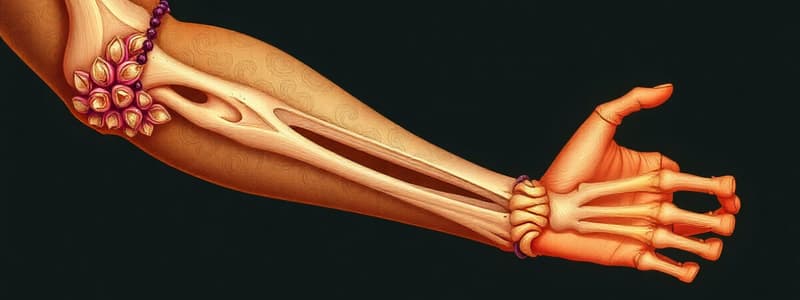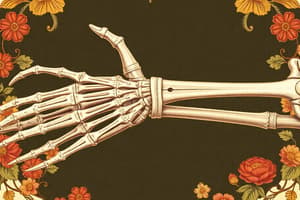Podcast
Questions and Answers
Type I fractures require immobilization in plaster cast for ______ weeks.
Type I fractures require immobilization in plaster cast for ______ weeks.
3
Type IV fractures involve radial head fracture associated with an ______ dislocation.
Type IV fractures involve radial head fracture associated with an ______ dislocation.
elbow
A Monteggia fracture involves a fracture of the upper third of the ______.
A Monteggia fracture involves a fracture of the upper third of the ______.
ulna
The Galeazzi fracture involves a fracture of the distal ______ of the radius.
The Galeazzi fracture involves a fracture of the distal ______ of the radius.
In the case of Type III fractures, treatment can involve ORIF or excision of radial ______.
In the case of Type III fractures, treatment can involve ORIF or excision of radial ______.
Elbow dislocations constitute ___% to ___% of all injuries to the elbow.
Elbow dislocations constitute ___% to ___% of all injuries to the elbow.
Among injuries to the upper extremity, dislocation of the elbow is second only to dislocation of the ___.
Among injuries to the upper extremity, dislocation of the elbow is second only to dislocation of the ___.
Simple dislocations of the elbow are those in which the injury is only ___ without any associated fractures.
Simple dislocations of the elbow are those in which the injury is only ___ without any associated fractures.
Posterior dislocation is by far the most common and is further subdivided by the direction of the dislocated ___.
Posterior dislocation is by far the most common and is further subdivided by the direction of the dislocated ___.
The 'terrible triad' elbow dislocation includes injuries to the coronoid process, radial head, and posterior lateral dislocation of the ___ joint.
The 'terrible triad' elbow dislocation includes injuries to the coronoid process, radial head, and posterior lateral dislocation of the ___ joint.
In children under ___ years, posterior elbow dislocations are the most common type of joint dislocation.
In children under ___ years, posterior elbow dislocations are the most common type of joint dislocation.
Simple posterior dislocation treatment involves ___ reduction under sedation.
Simple posterior dislocation treatment involves ___ reduction under sedation.
Active range of motion exercises should be started early as much as ___ after treatment.
Active range of motion exercises should be started early as much as ___ after treatment.
Complex or unstable elbow dislocation may require open reduction with or without internal ______.
Complex or unstable elbow dislocation may require open reduction with or without internal ______.
The palm-palm technique involves grasping the patient's hand with palms facing ______.
The palm-palm technique involves grasping the patient's hand with palms facing ______.
Extended casting should be avoided to prevent elbow post-traumatic ______.
Extended casting should be avoided to prevent elbow post-traumatic ______.
Active ROM is key to preventing post-traumatic stiffness and obtaining a favorable ______.
Active ROM is key to preventing post-traumatic stiffness and obtaining a favorable ______.
A hinged elbow brace is applied from day 5 to 7 at an angle of ______ to 90 degrees.
A hinged elbow brace is applied from day 5 to 7 at an angle of ______ to 90 degrees.
Radial head fractures often occur due to a fall on an ______ arm.
Radial head fractures often occur due to a fall on an ______ arm.
Limited ROM and swelling are common symptoms of a radial head ______.
Limited ROM and swelling are common symptoms of a radial head ______.
Strengthening exercises for the elbow can typically begin at ______ to 8 weeks post-injury.
Strengthening exercises for the elbow can typically begin at ______ to 8 weeks post-injury.
Flashcards
Elbow Dislocation - Types
Elbow Dislocation - Types
Elbow dislocations are categorized as simple (ligamentous injury only) or complex (with associated fractures).
Simple Posterior Elbow Dislocation
Simple Posterior Elbow Dislocation
Most common type, where the bones of the forearm (radius and ulna) are driven backward (posterior) relative to the upper arm bone (humerus).
Simple Anterior Elbow Dislocation
Simple Anterior Elbow Dislocation
The radius and ulna are driven forward (anterior) relative to the humerus.
Complex Elbow Dislocation
Complex Elbow Dislocation
Signup and view all the flashcards
"Terrible Triad" Elbow
"Terrible Triad" Elbow
Signup and view all the flashcards
Mechanism of Injury (PED)
Mechanism of Injury (PED)
Signup and view all the flashcards
Mechanism of Injury (Anterior PED)
Mechanism of Injury (Anterior PED)
Signup and view all the flashcards
Treatment - Simple PED
Treatment - Simple PED
Signup and view all the flashcards
Elbow Dislocation (Complex)
Elbow Dislocation (Complex)
Signup and view all the flashcards
Palm-Palm Technique
Palm-Palm Technique
Signup and view all the flashcards
Post-traumatic Elbow Stiffness
Post-traumatic Elbow Stiffness
Signup and view all the flashcards
Early Active ROM
Early Active ROM
Signup and view all the flashcards
Simple Elbow Dislocation Rehab
Simple Elbow Dislocation Rehab
Signup and view all the flashcards
Compressive Dressings & Ice
Compressive Dressings & Ice
Signup and view all the flashcards
Hinged Elbow Brace
Hinged Elbow Brace
Signup and view all the flashcards
Passive ROM (Elbow)
Passive ROM (Elbow)
Signup and view all the flashcards
Valgus Stress (Elbow)
Valgus Stress (Elbow)
Signup and view all the flashcards
Radial Head Fracture
Radial Head Fracture
Signup and view all the flashcards
Indirect Trauma
Indirect Trauma
Signup and view all the flashcards
Radial Head Fracture Types
Radial Head Fracture Types
Signup and view all the flashcards
Type I Radial Head Fracture
Type I Radial Head Fracture
Signup and view all the flashcards
Type II Radial Head Fracture
Type II Radial Head Fracture
Signup and view all the flashcards
Type III Radial Head Fracture
Type III Radial Head Fracture
Signup and view all the flashcards
Type IV Radial Head Fracture
Type IV Radial Head Fracture
Signup and view all the flashcards
Monteggia Fracture-Dislocation
Monteggia Fracture-Dislocation
Signup and view all the flashcards
Galeazzi Fracture-Dislocation
Galeazzi Fracture-Dislocation
Signup and view all the flashcards
Myositis Ossificans
Myositis Ossificans
Signup and view all the flashcards
ORIF
ORIF
Signup and view all the flashcards
Study Notes
Fractures & Dislocations of the Upper Limb
- Elbow dislocations account for 10% to 25% of elbow injuries. They are second only to shoulder dislocations in adults.
- Elbow dislocations are categorized as simple or complex.
- Simple dislocations involve ligamentous injuries only, without fractures. They can be anterior or posterior.
- Posterior dislocations are the most common type. They can be further categorized by the direction of the dislocated ulna (posterior, posteromedial, posterolateral, or direct lateral).
- Complex dislocations include associated fractures, frequently involving the radial head, coronoid process of the ulna, and the olecranon. The "terrible triad" is a common complex dislocation with these three elements, and possible posterior lateral dislocation of the elbow joint.
- Nerve and blood vessel damage such as ulnar/median neuropraxia and possible brachial artery injury may be associated with complex dislocations.
- Ulnar collateral ligament tears can also accompany elbow dislocations.
Mechanism of Injury
- Posterior elbow dislocations (PEDs) are most common in children under 10 years old, usually resulting from falls on an outstretched hand or elbow.
- Forceful unlocking of the olecranon from the trochlea is involved.
- Axial compression, valgus stress, arm abduction, and forearm supination can contribute to PEDs.
- Anterior dislocations usually result from direct force to the posterior forearm during elbow flexion.
Treatment
- Simple posterior dislocations are treated by closed reduction under sedation, then fixation in a plaster cast or posterior splint, holding the elbow at 90 degrees for 2-3 weeks. Active range-of-motion exercises are started as soon as possible.
- Complex or unstable dislocations, significant soft tissue or bone damage will need open reduction with or without internal fixation, and often ulnar collateral ligament repair.
Reduction of Posterior Elbow Dislocation
- Palm-palm technique: The physician grasps the patient's hand, with palms together and fingers interlocked, and places their elbow in the patient's antecubital fossa.
- The physician pushes down on the patient's distal humerus to distract the dislocation.
- By pulling the posteriorly dislocated elbow back into its proper anatomical position using gentle pressure to the olecranon.
Rehabilitation Considerations
- Avoid prolonged immobilization, as it can lead to post-traumatic elbow stiffness.
- Early active range of motion (ROM) is key for recovery.
- The elbow is splinted for 5 to 7 days to promote soft tissue healing.
- Ice and compressive dressings manage swelling.
- A hinged elbow brace is applied, with ranges of motion from 30 to 90 degrees, increasing gradually.
- Active ROM exercises are initiated to promote muscle activation and stability.
Additional Considerations (Up to 2 Weeks Post-Injury)
- Avoid passive range of motion (ROM), as it can increase swelling and inflammation.
- Avoid valgus stress to the elbow to promote healing of the medial collateral ligament (MCL).
- Avoid abduction and external rotation of the arm.
- Avoid forced terminal extension.
- Resistive exercises are avoided, as they exert tension on healing ligamentous structures.
Radial Head Fracture
- Radial head fractures typically occur from indirect trauma, often after a fall on an outstretched arm.
- A fall affecting the abducted arm during 0-80 degrees of elbow flexion often results in a valgus pronation stress, forcing the radial head against the capitulum of the humerus.
- Common complications include limited range of motion (ROM) and maximal tenderness over the radial head. (10-15 degrees of ROM limitation is common)
- Fracture types are classified by displacement and comminution (Type I-IV).
- Treatment depends on fracture type. Type I usually involves immobilization; more complex types typically involve open reduction and internal fixation (ORIF) or radial head excision.
Forearm Bone Shaft Fractures
- These injuries include Monteggia fractures (proximal ulna fracture with radial head dislocation) and Galeazzi fractures (distal radius fracture with inferior radioulnar joint dislocation). Both injuries often require surgical intervention (ORIF).
Studying That Suits You
Use AI to generate personalized quizzes and flashcards to suit your learning preferences.



